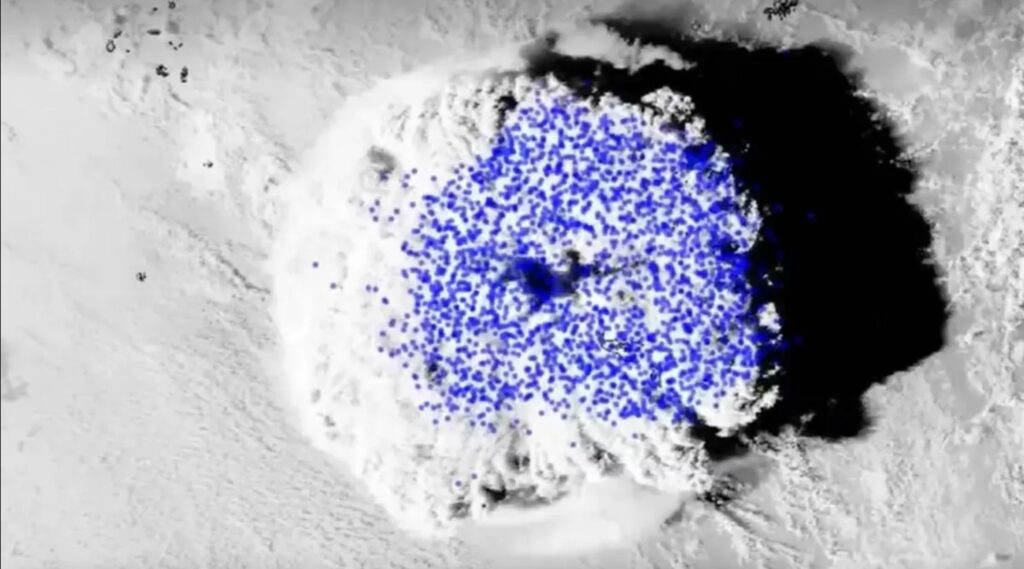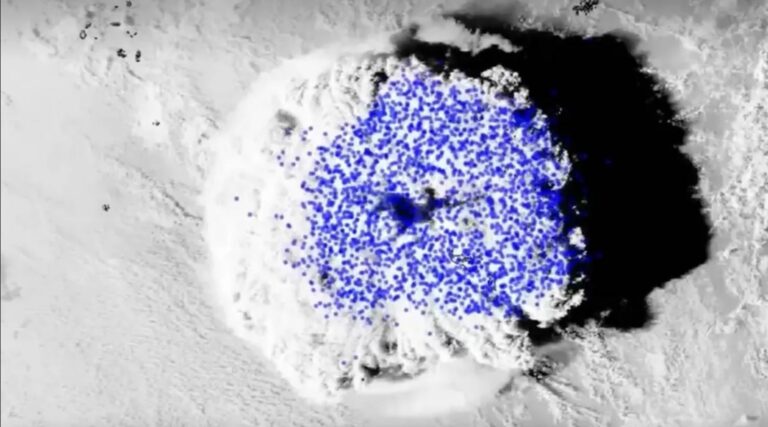Underwater Volcano in Tonga Creates Most Intense Lightning Storm Ever Documented
Unprecedented Lightning Activity and Soaring Ash Plume Mark January 2022 Eruption
According to a recent study, the eruption of the Hunga Tonga-Hunga Ha’apai volcano in January 2022 not only resulted in the most powerful atmospheric explosion ever recorded but also unleashed an extraordinary number of lightning strikes during an electrifying thunderstorm that lasted for 11 hours and spanned across 150 miles (240 km).

Situated in the southern Pacific Ocean, the volcano began its eruption in December 2021. However, the most explosive event took place on January 15, 2022. Despite the volcano’s caldera being submerged 500 feet (150 meters) below sea level, the eruption forcefully breached the water’s surface, propelling a colossal ash plume to reach an astonishing height of 36 miles (58 km). The eruption had a staggering eruption rate of 11 billion pounds (5 billion kilograms) per second, surpassing the magnitude of the Mount St. Helens eruption in May 1980.
“The Hunga Tonga eruption defied the theoretical limits of plume height and eruption rate, surpassing all expectations,” explained Alexa Van Eaton, the lead author of the study from the U.S. Geological Survey, in an interview with Space.com.
Among the numerous records broken by the eruption, one stood out prominently—the astonishing number of lightning strikes generated by the plume. This event marked the most intense lightning storm ever witnessed, with a peak rate of 2,600 flashes per minute and a cumulative total of approximately 192,000 flashes over the course of 11 hours. What made this phenomenon even more remarkable was its occurrence at an unprecedented altitude, ranging between 12 and 19 miles (20 to 30 km) above the Earth’s surface—higher than any previously observed lightning activity. The lightning strikes were detected using a network of radio antennae designed for storm tracking, as well as two Earth-orbiting spacecraft: the U.S. National Oceanic and Atmospheric Administration’s (NOAA) GOES-17 satellite and the Japanese Meteorological Agency’s Himawari-8 satellite.
“We have never witnessed such an extraordinary rate of lightning activity, especially at such extreme altitudes,” remarked Van Eaton, expressing her amazement at the spectacle.
Satellite imagery revealed that the lightning was not dispersed randomly throughout the plume, but rather formed distinct concentric rings, closely linked to each explosive outburst originating from the volcano. As the plume ascended, it expanded and assumed the shape of an “umbrella cloud,” with cascading material falling back onto it and oscillating within a layer of neutral buoyancy.
“This induced a tremendous vertical motion within the cloud, resulting in a gravity wave propagating outward from the center of the plume, spanning a vertical distance of 10 kilometers [6 miles] from peak to trough,” explained Van Eaton. This oscillating pressure wave, known as a gravity wave (distinct from gravitational waves generated by merging celestial objects), was the primary source of the lightning activity.
The lightning within these ring-shaped gravity waves may have formed through two mechanisms. As the eruption occurred underwater, it injected substantial amounts of water into the Earth’s atmosphere. Consequently, the resulting ice crystals acquired positive and negative charges. Additionally, the volcanic ash, composed of fragmented rock and magma ejected into the air, became ionized, creating regions of positive and negative charge. The gradient in electrical charge between these regions sparked the sudden bursts of lightning.
Although lightning rings have been observed in volcanic plumes previously, the Hunga Tonga eruption was the first instance where multiple rings were detected—specifically four, corresponding to the four distinct phases of the volcanic eruption. The lightning seemed to ride the undulating rings, akin to a surfer navigating ocean waves.
Typically known as “lightning holes” due to the absence of lightning within the ring, the Hunga Tonga eruption demonstrated a remarkable deviation from this norm. Within minutes of the gravity wave passing through, the holes began filling with lightning—an unprecedented occurrence. The precise mechanism behind this phenomenon remains unclear.
The presence of lightning during the eruption highlights its potential for serving as an early warning sign of volcanic activity. Ordinarily, volcanologists must rely on satellite detection and imaging, which can take around 10 minutes to provide crucial information to emergency services. However, lightning strikes can be detected at the speed of light using radio frequencies. This rapid detection surpasses the speed of satellites, winds, seismic waves, and infrasound. Consequently, lightning may offer invaluable insights for timely response and mitigation efforts, preventing catastrophic consequences such as tsunamis, hurricane winds, pyroclastic flows, and aviation disruptions caused by volcanic ash.
Beyond its contemporary records, the Hunga Tonga eruption holds potential implications for understanding ancient volcanism on Earth and even other celestial bodies. The eruption exhibited characteristics of a phreatoplinian volcano, resulting from the eruption of molten rock through a substantial water layer. Such a colossal explosive underwater volcanic event has only been observed in the geological records.
Moreover, the eruption’s findings could shed light on the initiation of lightning on other planets, including Venus, or celestial bodies where conventional lightning is not typically expected. Van Eaton noted that the eruption may have implications for understanding the dynamics of lightning on other worlds, such as Jupiter’s moon Io, where volcanic activity is abundant, or the Saturn moon Enceladus, known for cryovolcanism. The possibility of lightning within the water jets of Enceladus raises intriguing questions about the atmospheric disturbances that might occur in these unique environments.
Van Eaton contemplated, “Could Enceladus support lightning with its major water jets? I don’t know, but it seems that this is an unexplored avenue for understanding significant atmospheric perturbations in other planetary realms.”
The research was published online today (June 19) in the journal Geophysical Research Letters.
Do not forget to share your opinion with us to provide you with the best posts !




0 Comments